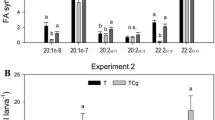Abstract
The distribution of n-3 highly unsaturated fatty acids (HUFA) over the major neutral and polar lipid classes was determined for two predominant types of live food used in the larviculture of marine fish and shrimp, i.e. freshly hatched and HUFA-enriched Artemia, and compared with data reported in the literature for wild copepods, representing the natural diet of these larvae. Lipid class composition and their content of n-3 HUFA, particularly eicosapentaenoic acid (EPA, 20:5n-3) and docosahexaenoic acid (DHA, 22:6n-3), were assessed in freshly hatched, HUFA-enriched and subsequently starved Artemia franciscana. The n-3 HUFA enrichment was based on feeding Artemia a lipid emulsion in which either fatty acid ethyl esters (EE, diluted with olive oil) or triacylglycerol (TAG) provided a level of 30% n-3 HUFA. Enrichment of Artemia with either type of the lipid emulsions resulted in an increase of total lipid content from 20.0 to 28.2–28.7% of dry matter mainly due to the accumulation of neutral lipid, primarily TAG (from 82 to 158 mg g−1 dry wt in freshly hatched and 24-h enriched Artemia). Enriched brine shrimp utilized up to 27–30% of their TAG content during 72 h of starvation at 12 °C. The absolute tissue concentrations of polar lipids remained constant at 71 to 79 mg g−1 dry wt throughout the enrichment and subsequent starvation. The level of n-3 HUFA increased drastically during enrichment from 6.3% of total fatty acids (8.2 mg g−1 dry wt) in freshly hatched nauplii to between 20.4 and 21.8% (40.4 to 43.2 mg g−1 dry wt) in 24-h enriched Artemia and was not significantly affected by the source of n-3 HUFA. During starvation, 18:0, 20:4n-6 and 20:5n-3 were retained, whereas 18:4n-3, 22:5n-3 and 22:6n-3 were specifically catabolized. The major polar lipids, phosphatidylethanolamine (PE) and phosphatidylcholine (PC), of freshly hatched Artemia showed very low levels of DHA (<0.1% of total fatty acids) and carried about 45% of the total EPA present. Enrichment with either of the emulsions resulted in an increase of the neutral lipid fraction which concentrated >64% of the EPA and >91% of the total DHA present. This is in sharp contrast with the high levels of n-3 HUFA, in particular DHA, in the polar lipid fraction reported for wild copepods. The contrasting distribution of DHA in the neutral and polar lipid fractions of enriched brine shrimp compared to the natural diet may influence the efficacy of this essential fatty acid for marine fish larvae in aquaculture systems.
Similar content being viewed by others
Author information
Authors and Affiliations
Additional information
Received: 10 June 1997 / Accepted: 8 August 1997
Rights and permissions
About this article
Cite this article
Coutteau, P., Mourente, G. Lipid classes and their content of n-3 highly unsaturated fatty acids (HUFA) in Artemia franciscana after hatching, HUFA-enrichment and subsequent starvation. Marine Biology 130, 81–91 (1997). https://doi.org/10.1007/s002270050227
Issue Date:
DOI: https://doi.org/10.1007/s002270050227




